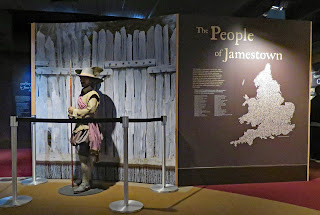
Tuesday, November 30, 2021
Historic Jamestowne

Sunday, November 28, 2021
Thomas Stone National Historic Site
The house is open for tours but during our visit it was closed due to coronavirus. The visitor center has a few exhibits. A couple of trails loop through the property and provide access to the outbuildings and tenant house.
The visitor center is accessible. The trail to the house starts as a boardwalk but the majority of it is over lumpy, grassy ground which is tough to push through. The loop trails are also grassy and a hill south of the tenant house is extremely steep. I do not recommend trying the loop trails. There’s an accessible parking space at the house so driving to it may be an option. There’s ramp to one section of the house


The parking lot is large enough for any RV. Park 38.53027, -77.03588
Friday, November 26, 2021
Smallwood State Park
The park is located on the Mattawoman Creek where it flows into the Potomac River. None of the sites border the creek but there is a marina and boat ramp. Smallwood’s house has been renovated and is open to tour on very limited dates. A couple of trails meander through the property.
I don’t like to make reservations because it’s hard to tell the condition of the sites and plus there’s often a reservation fee which makes the campsite expensive for a one night stay. Occasionally that backfires. Due to coronavirus all sites at Smallwood must be reserved. Our internet was slow to bring up the park site and we had to call the Maryland park office with only minutes to spare before it closed. Luckily we ended up with a very nice site.
Thursday, November 25, 2021
Theodore Roosevelt Island

The island features a large statue of Roosevelt and several miles of trail.
Tuesday, November 23, 2021
Slave Quarters at Arlington House
Follow the signs for RV parking. We did not have to pay a parking fee this time which may have to do with coronavirus. Quarters 38.88127, -77.07288
Sunday, November 21, 2021
C&O Canal Towpath–Great Falls
Saturday, November 20, 2021
Huntley Meadows Park
 The Nature Center is accessible. The trail around the pond is accessible. The trail to the house is hardpacked dirt and asphalt in poor condition and not marked well. Visitor with mobility issue should drive to the house. The brick road to the house from the small parking lot is steeply uphill. We did not tour the house interior but it looks like the first floor is accessible. We did not take the trail from the South Kings Highway parking lot.
The Nature Center is accessible. The trail around the pond is accessible. The trail to the house is hardpacked dirt and asphalt in poor condition and not marked well. Visitor with mobility issue should drive to the house. The brick road to the house from the small parking lot is steeply uphill. We did not tour the house interior but it looks like the first floor is accessible. We did not take the trail from the South Kings Highway parking lot.













































